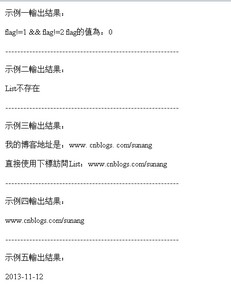我的开发环境
框架:springmvc+freemarker
开发工具:springsource-tool-suite-2.9.0
JDK版本:1.6.0_29
tomcat版本:apache-tomcat-7.0.26
step1.编写controller文件,代码如下:
package www.asuan.com.controller;
import java.util.ArrayList;
import java.util.Date;
import java.util.HashMap;
import java.util.List;
import java.util.Map;
import org.springframework.stereotype.Controller;
import org.springframework.ui.Model;
import org.springframework.web.bind.annotation.RequestMapping;
@Controller
public class HelloWorldController {
@RequestMapping("/helloWorld")
public String helloWorld(Model model) {
// 示例一
int flag = 0;
model.addAttribute("flag", flag);
// 示例二
List<String> noExistList = new ArrayList<String>();
noExistList = null;
model.addAttribute("noExistList", noExistList);
// 示例三
List<String> strList = new ArrayList<String>();
strList.add("www.");
strList.add("cnblogs.");
strList.add("com/sunang");
model.addAttribute("strList", strList);
// 示例四
Map<String, String> strMap = new HashMap<String, String>();
strMap.put("mapKey0", "www.");
strMap.put("mapKey1", "cnblogs.");
strMap.put("mapKey2", "com/sunang");
model.addAttribute("strMap", strMap);
// 示例五
Date nowTime = new Date();
model.addAttribute("nowTime", nowTime);//传输时间对象
return "helloWorld.ftl";
}
}
step2.编写ftl文件,代码如下:
<html>
<body>
示例一输出结果:
<p>
<#– if指令的用法–>
<#– 在指令标籤内直接使用变量名得到文本值–>
<#if flag == 1>
flag = 1
<#elseif flag ==2>
flag = 2
<#else>
<#– 在指令标籤外使用 ${变量名} 的格式来得到文本值–>
flag!=1 && flag!=2 flag的值為:${flag}
</#if>
</p>
<p>———————————————————-</p>
示例二输出结果:
<p>
<#– 判断变量是否存在–>
<#if noExistList??>
List存在
<#else>
List不存在
</#if>
</p>
<p>———————————————————-</p>
示例三输出结果:
<p>
<#– list指令的用法,as可设置别名–>
<#list strList as sl>
<#– 在变量名后加 _index 得到变量在容器中的序号,从0开始–>
<#if sl_index == 0>
我的博客地址是:${sl}
<#else>
${sl}
</#if>
</#list>
</p>
<p><p></p>
直接使用下标访问List:${strList[0]}${strList[1]}${strList[2]}
</p>
<p>———————————————————-</p>
示例四输出结果:
<p>
<#– 使用 ${变量名.变量名} 获取容器对象的子对象–>
${strMap.mapKey0}${strMap.mapKey1}${strMap.mapKey2}
</p>
<p>———————————————————-</p>
示例五输出结果:
<p>
<#– 当变量是日期对象时,可使用函数使其按格式输出–>
${nowTime?string("yyyy-MM-dd")}
</p>
</body>
</html>
step3.运行与调试
将工程部署到tomcat并运行,在瀏览器输入:http://localhost:8080/你设置的工程名/helloWorld.htm
运行结果:
相关文章
- ASP.NET自助建站系统的域名绑定与解析教程 2025-06-10
- 个人服务器网站搭建:如何选择合适的服务器提供商? 2025-06-10
- ASP.NET自助建站系统中如何实现多语言支持? 2025-06-10
- 64M VPS建站:如何选择最适合的网站建设平台? 2025-06-10
- ASP.NET本地开发时常见的配置错误及解决方法? 2025-06-10









